Whatever epoch in time we belong to, we want to be beautiful. The ideals vary, but no matter what they look like, that is what we want to look like. In the 18th century it was beautiful to have pale skin to show that you could afford not to work in the sun. Rosy-red cheeks was a sign of health, and the, preferable, bud-like mouth was to be red as well. As a contrast to all the white and red, a black, well-placed beautymark did the trick. The eyes weren’t painted, but the eyebrows should be dark. The skin was to be shiny- like porcelain, but not the hair. Powder made it suitably dull to contrast beautifully to the face.


It is pictures we have to turn to, if we want to see how people looked back then, but to use paintings as proof can be a bit risky. The freedom of the artist (or the demands of the customer) may transform and beautify. Like this portrait by Roslin of Queen Lovisa Ulrika. A contemporary description of her says that her skin was very wrinkled and destroyed, but even if the portrait shows an elderly woman, her skin doesn’t look that bad.

Still, the paintings mirror the taste and ideals, so of course some conclusions can be drawn from them. An example is that the really pale faces, seems to belong more to the early 18th century and to the most formal occasions. Rouge, on the other hand, seems to be used even when the skin tone is more natural than white.

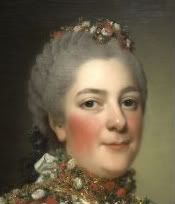

It is two different artists that portray the very pretty Charlotta Fredrika Sparre in the middle of the 18th century, but it is still interesting to see one person in two very different faces. She is wearing masquerade costume on both portraits, but as a vestal her face is unpainted, apart from the rouge and her hair has its natural colour. As La Folie her face is pale and her hair powdered.


Many of the ingredients at the time were poisonous and therefore I haven’t used them. How period it may be with white and red from lead, tin and cinnabar, they are bad for you and I haven’t used them. Titanium oxide and zinc oxide are white pigments that came during the 19th century and work in the same way as white from lead and tin and can used as substitutes. I probably don’t need to say this, but I do anyway; Never use poisonous products on your skin!
Another ingredient that often turns up is spermaceti, a waxy substance that comes from the Sperm Whale.. It is not poisonous and perhaps you can get it today, if you are prepared to pay for it. I haven’t checked that out as I don’t find it very ethical. Jojoba oil works very similar and I have used that instead.
My beautiful models, Caroline and Abigail, in their natural state.

And after.
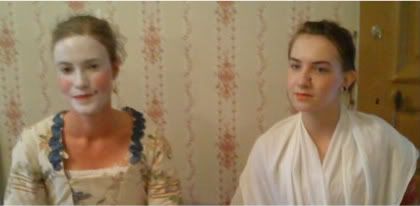
As I mentioned before, pale skin was the thing to have and it was supposed to be shiny too. A beautiful skin is often described as varnished, or glazed. Even without white make-up a shiny surfaced could be created with a lotion that contained nacre. Or use “An Admirable Varnish For the Skin”, a mixture of egg white, juice of lemon and some rosewater. Works very well, at least until the egg white is dry and starts to peel off… Rouge could be found in a number of red shades and could be placed all over the cheek, much in the same manner a blush spreads. Or it could be a smaller field on the middle of the cheek, or on the cheek bone.

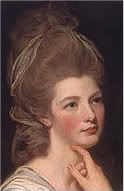
Caroline's make-up is rather heavy, the white pigment is Titan Oxide. I bought the pigment as a powder, so to make it stick I needed something for it to stick to. There are a number of recipes for pomades and I chose to make one that contained almond oil, bees wax, jojoba oil and a little rose water. It became a very thick cream and after spreading it on Caroline's face I dipped a sponge in the pigment and worked it in. It was a bit tricky to make it cover evenly and the end result became rather sticky. As this was just a test make-up, I just painted Caroline's face, had it been for a ball I would have painted all visible skin.

In the 18th century you didn't use different products for lips and cheeks and on Caroline I used red pomade on both. The red in it comes from alkanet root. To colour her eyebrows I used burnt clove. It gives a rather good colour, but unfortunately I had got pomade on the eyebrows and they got a bit too grey. To finish the make-up off, I put on two beauty marks. These were cut out from black paper, but I've used black taffeta before. If you use fabric, then it's good to prepare it so it doesn't unravel. A thin layer of glue work very well.
I used the same technique on Abigail, but different products. Instead of Titan Oxide I used talcum powder and you can see that it gives a very different result. Her skin got a little paler and it didn’t get as shiny either. Zinc Oxide is supposed to cover better, though not as well as Titan Oxide, and I would really like to test that too, one day.
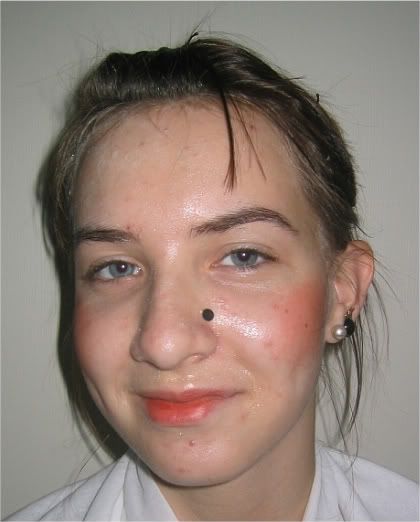
Abigail’s cheeks and mouth is painted with liquid rouge. The red colour here is from red sandalwood and Brazil wood that has been soaked in brandy. I promise that you can tell when you sniff the bottle! This colour is much more yellow in its tone that the rouge with alkanet root it’s a bit tricky to apply as its liquid,. I found it easier to work with if I just took a little at the time. Then it’s also easier to build up to the strength of colour you want, if you just let it dry between applications.
It’s clear when you try these pigments out that they behave very differently. The ladies, and gentlemen, of the time did have a choice on how pale they wanted to be. Perhaps it’s not so wrong to assume that really white and poisonous make-up was saved for the really grand occasions. People didn’t die of lead poison in droves, after all and all the case I have read about has been about ladies who was known to be very heavily made-up at all times.
Most people know that they powdered their hair white in the 18th century, but that wasn’t the only colour that was used, though it was the most common. Hair that has been powdered white doesn’t get white, it gets grey, more or less dark depending on your natural hair colour. Even if you could colour you hair black, or bleach it with lye, these methods were hard to control and the results unpredictable. To powder the hair was an easy way to change the colour. There were black powder as well as brown, grey and blond and if you were dating, there were also blue, pink and lavender. To get the powder to stick to the hair, the coiffure needed to be prepared with pomade, which could have been made from animal fat. As I used myself as guinea pig for the hair powdering and I really didn’t want to have animal fat in my hair, I used a modern substitute in the form of hair wax. I, or rather Caroline, used a big powder brush to apply the powder. We did it outside and I was wrapped in a sheet to protect face and clothes. Getting powder in your nose and throat is not funny!
This is how it looked after a go with the white powder. I find that the big brush method works fairly well, but I was a bit short of time and applied the wax unevenly- you can clearly see where it has stuck best. My hair is dark brown and it got rather grey. We used talcum powder, but starch, flour and ground up plaster of Paris was also used.
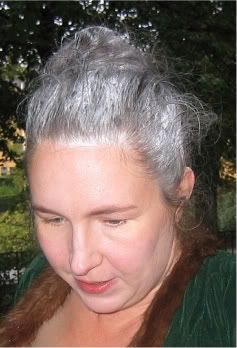
I have always wanted to try out coloured powder and decided that this would be a good occasion to try blue. The best would probably be to buy coloured pigment as a powder and mix with the white one, my guess is that that is what they did in the 18th century- as an example there is a recipe for blond powder where yellow ochre is recommended. But what I did was to but a crayon of dry pastels and pulverized it. A word of caution, though. Coloured pigment is even nastier to get in your lungs than plain powder.
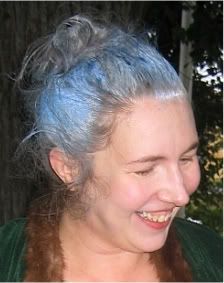
My hair got beautifully blue! And the blue stuck to my scalp very well, it took me three washed to get rid of it all. If you powder your hair you have to take into account that it do disappear gradually as the day go by. But take it as a comfort that this is very period- it happened back then too.
Though I’ve held this lecture a number of times, I still learn more and each time I have new information. My lecture is very much a work in progress and I appreciate comments and questions. What I’ve said here is what I found to be true from the sources I’ve had and I’m always on the lookout for more information.
A big thank you to my models and to Madame Berg, who provided some pictures.!

La Couturière Parisienne have a section on 18th century beauty I found the recipe for the face pomade here, as well as modern substitutes for white pigment and that they don’t all behave the same.
Ageless Artifice A company that makes beauty products after historical recipes. They have a limited assortment at the moment, but plan to enlarge it. I bought the liquid rouge and the red pomade from them, and I’m very satisfied with their service, products and prices.
Black Phoenix Alchemy Lab A perfume company that makes a few perfumes after historical recipes. They make two 18th century perfumes, Marie for the ladies and Vicomte de Valmont for the gentleman.
The Toilets of Flora A complete beauty book from 1779, online, with everything you need to be the perfect beauty, rococo-style.
3 comments:
Interesting interpretation, but the models do both look quite tanned (for 18th century standards that is) the zinc oxide would have been less contrasted, also wouldn't the necks be blended in too?
I read somewhere that Roman women powdered their faces with lead to keep themselves pale (also made their skin terribly sag amoung other more serious medical issues) I'm guessing this would have been carried over from then and the finish would have been more matte than shiny.
A little interesting ditty, Sudocrem is predominantly zinc oxide if anybody would like try this out at home :)
Have you looked into Bourjois blush? Because there used to be quite long descriptions on the website about why Bourjois was such a revolutionary product in the mid 19th century.
It is a bit difficult to find people who hold to 18th century paleness, so yes, they are a bit more tanned than a lady back then would have been. :) The neck would have been painted as well, absolutely, as well as visible skin on the arms. I didn't here as the make up was done as part of a presentation, so just the face was done for time reasons. It's also a bit uneven- I have tried the same method on myself and with bmore time and work it gets better.
In the 18th century the ideal finish of the face was just shiny, not matte. I have come across several method for keeping the desireable shine, but just powdering the face doesn't seem to have been done- powder was reserved for the hair. There are even recipes for just adding shine to your face if you don't want to paint it white.
Sudocrem isn't aviable in Sweden, alas, but I suspect there are similar products. There is often zinc in mineral make up too.
No, I haven't, so thank you for the tip. I shall check Bourous out.
I'm so glad to have stumbled upon your blog. It has provided wonderful resources and information for my research. I am creating an historical fiction graphic novel based in 18th century Sweden called Badin and the Secret of the Saami (due out fall 2016--http://blackrhinoillustration.blogspot.com/). All the little details you give about hair styles and even that little part about Drottning Lovisa Ulrika'very wrinkled skin have been very useful. I'm definitely going to credit you in the book.
Post a Comment